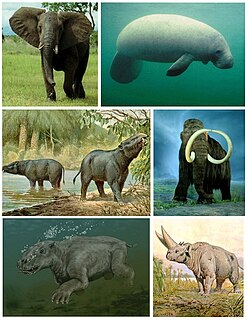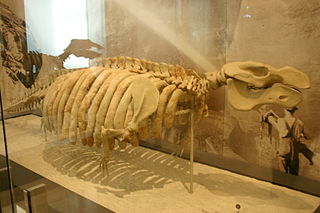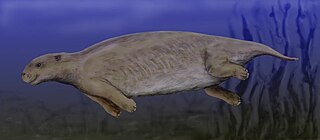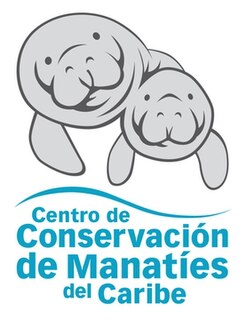| Potamosiren | |
|---|---|
| Scientific classification | |
| Kingdom: | |
| Phylum: | |
| Class: | |
| Order: | |
| Family: | |
| Subfamily: | |
| Genus: | Potamosiren Reinhart 1951 |
| Species | |
| |
Potamosiren is an extinct genus of manatee from the Middle Miocene (Laventan) Honda Group of Colombia. [1]
A 2014 cladistic analysis of extinct sirenians recovers Potamosiren as a close relative of modern manatees. [2]

The Sirenia, commonly referred to as sea-cows or sirenians, are an order of fully aquatic, herbivorous mammals that inhabit swamps, rivers, estuaries, marine wetlands, and coastal marine waters. The Sirenia currently comprise two distinct families: Dugongidae and Trichechidae with a total of four species. The Protosirenidae and Prorastomidae families are extinct. Sirenians are classified in the clade Paenungulata, alongside the elephants and the hyraxes, and evolved in the Eocene 50 million years ago (mya). The Dugongidae diverged from the Trichechidae in the late Eocene or early Oligocene.

Trichechidae is a family of sirenians that includes all living manatees and several extinct genera.

The Desmostylia are an extinct order of aquatic mammals that existed from the early Oligocene (Rupelian) to the late Miocene (Tortonian).

Paenungulata is a clade of "sub-ungulates", which groups three extant mammal orders: Proboscidea, Sirenia, and Hyracoidea (hyraxes). At least two more possible orders are known only as fossils, namely Embrithopoda and Desmostylia.

Hydrodamalis is a genus of extinct herbivorous sirenian marine mammals, and included the Steller's sea cow, the Cuesta sea cow, and the Takikawa sea cow. The fossil genus Dusisiren is regarded as the sister taxon of Hydrodamalis: together, the two genera form the dugong subfamily Hydrodamalinae. They were the largest member of the order Sirenia, whose only extant members are the dugong and the manatees. They reached up to 9 metres (30 ft) in length, making the Steller's sea cow among the largest mammals other than whales to have existed in the Holocene epoch. Steller's sea cow was first described by Georg Wilhelm Steller, Cuesta by Daryl Domning, and Takikawa by Hitoshi Furusawa. The Steller's sea cow was the only member of the genus to survive into modern times, and, although had formerly been abundant throughout the North Pacific, by the mid 1700s, its range had been limited to a single, isolated population surrounding the uninhabited Commander Islands. It was hunted for its meat, skin, and fat by fur traders, and was also hunted by aboriginals of the North Pacific coast, leading to its and the genus' extinction 27 years after discovery. The Cuesta sea cow along with the Takikawa sea cow were probably extinct at the end of the Pliocene due to the onset of the Ice Ages and the subsequent recession of seagrasses—their main food source.

A flipper is a broad, flattened limb adapted for aquatic locomotion. It refers to the fully webbed, swimming appendages of aquatic vertebrates that are not fish.

The Amazonian manatee is a species of manatee that lives in the Amazon Basin in Brazil, Peru, Bolivia, Colombia, Ecuador and Venezuela. It has thin, wrinkled brownish or gray colored skin, with fine hairs scattered over its body and a white chest patch. It is the smallest of the three extant species of manatee.

Sirenia is the order of placental mammals which comprises modern "sea cows" and their extinct relatives. They are the only extant herbivorous marine mammals and the only group of herbivorous mammals to have become completely aquatic. Sirenians are thought to have a 50-million-year-old fossil record. They attained modest diversity during the Oligocene and Miocene, but have since declined as a result of climatic cooling, oceanographic changes, and human interference. Two genera and four species are extant: Trichechus, which includes the three species of manatee that live along the Atlantic coasts and in rivers and coastlines of the Americas and western Africa, and Dugong, which is found in the Indian and Pacific oceans.

Pezosiren portelli, also known as the "walking manatee", is a basal sirenian from the early Eocene of Jamaica, 50 million years ago. The type specimen is represented by a Jamaican fossil skeleton, described in 2001 by Daryl Domning, a marine mammal paleontologist at Howard University in Washington, DC. It is believed to have had a hippopotamus-like amphibious lifestyle, and is considered a transitional form between land and sea mammals:.

Metaxytherium is an extinct genus of dugong that lived from the Miocene until the end of the Pliocene. Fossil remains have been found in Africa, Asia, Europe, North America, and South America.
Protosiren is an extinct early genus of the order Sirenia. Protosiren existed throughout the Lutetian to Priabonian stages of the Middle Eocene. Fossils have been found in the far-flung locations like the United States, Africa (Egypt), Europe and Asia.
Nanosiren garciae is an extinct sirenian dugong that lived in warm shallow seas in what is now Venezuela, approximately 11.610—3.6 Ma during the Miocene and Pliocene. The species is listed in the Paleobiology Database, funded by the Australian Research Council.

Prorastomidae is a family of extinct sirenians from Jamaica, related to the extant manatees and dugong. The family includes the oldest known fossils of Sirenians, represented in two genera:
Protosirenidae is an extinct primitive family of the order Sirenia.

Hemipristis serra is an extinct species of weasel shark which existed during the Miocene epoch. It was described by Louis Agassiz in 1843. While today's snaggletooth shark is not very large or dangerous, Hemipristis serra, which lived in the Atlantic Ocean during the Oligocene and Miocene, was considerably larger than its modern-day relative and had much larger teeth. Its total length is estimated to be with 6 metres (20 ft) long. Marks made by the teeth of H. serra are often found on the bones of the manatee Metaxytherium leading some scientists to hypothesize that H. serra specialized in preying on these sirenians. In the Gatun Formation of Panama, H. serra was contemporary with pups of the large lamniform shark Otodus megalodon, and both it and the great hammerhead are theorized to have preyed on the pups of this larger shark due to their presence within the formation.

The Caribbean Manatee Conservation Center is a research, education, rescue, and rehabilitation partnership established in 2009 in the Caribbean island of Puerto Rico in order to help endangered manatees survive from extinction.
Pachyosteosclerosis is a combination of thickening (pachyostosis) and densification (osteosclerosis) of bones. It makes bones more heavy, but also more fragile. The condition often occurs in aquatic vertebrates, especially those living in shallow waters, creating ballast as an adaptation for maintaining neutral buoyancy and horizontal trim. It is in no way pathological. To resist bend, it frequently is found especially in ventral bones, whereas concentration near the lungs helps in maintaining trim. Examples of animals showing pachyosteosclerosis are seacows, the extinct Plesiosauria and Mesosauria and extinct aquatic sloths.

Miosiren is an extinct genus of manatee from the Early Miocene of southeastern England (Suffolk) and Antwerp, Belgium.
Anomotherium is an extinct genus of manatee that lived in the shallow seas of what is now northern Germany. Its closest relative is Miosiren. Fossils of the genus have been found in the Bohlen and Doberg Formations of Germany.

The Cuesta sea cow is an extinct herbivorous marine mammal, and the direct ancestor of the Steller's sea cow. They reached up to 9 metres (30 ft) in length, making them among the biggest sirenians to have ever lived. They were first described in 1978 by Daryl Domning when fossils in California were unearthed. Its appearance and behavior are largely based on that of the well-documented Steller's sea cow, which, unlike the Cuesta sea cow, lived into modern times and was well-described.